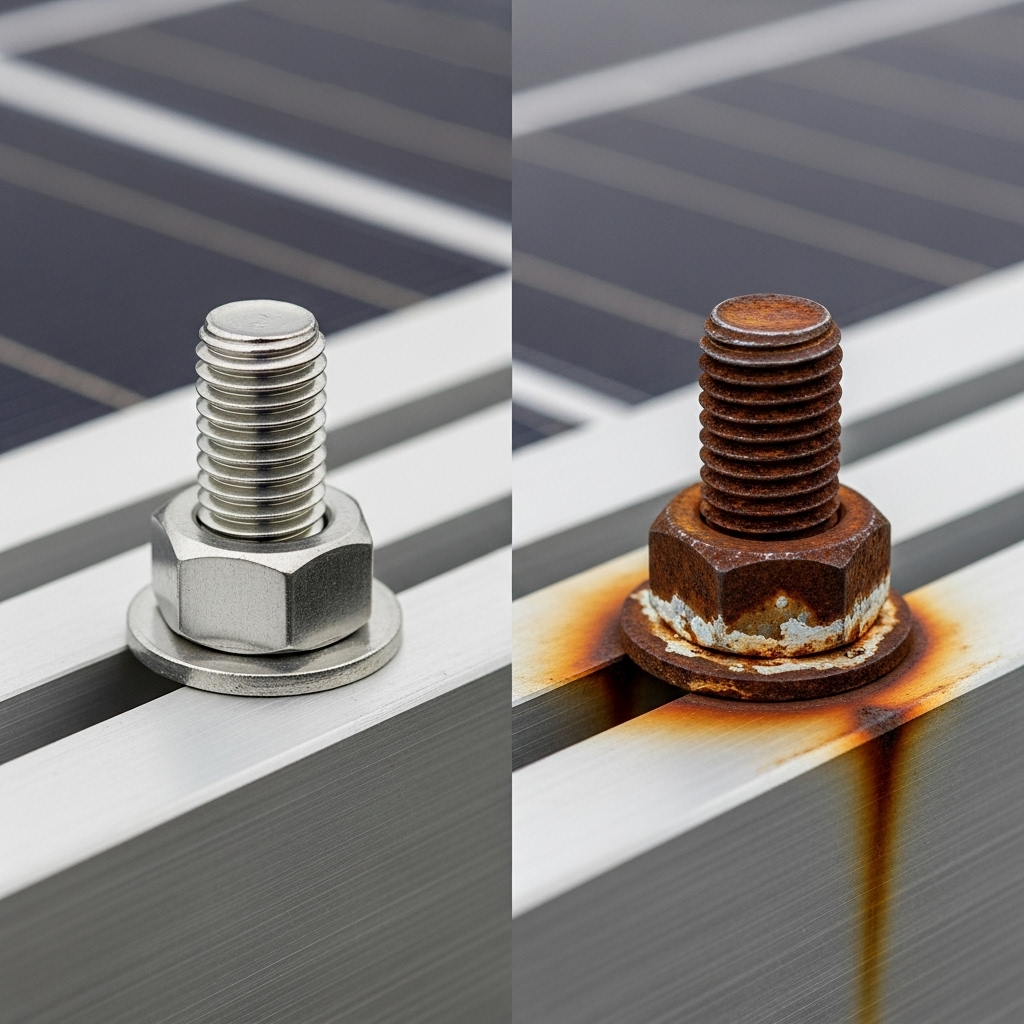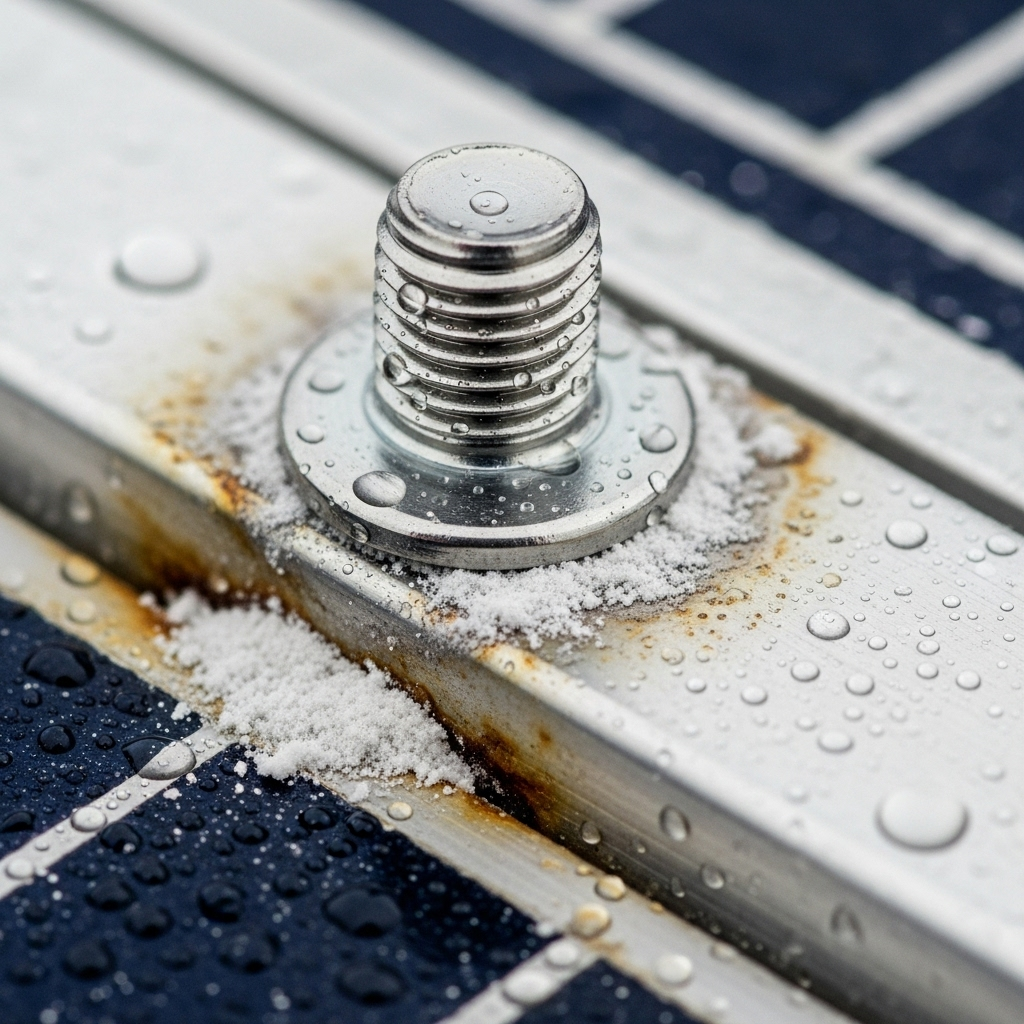The long-term performance of a solar energy system depends on the durability of every component. While solar panels and inverters often get the most attention, the small fasteners holding the racking structure together are critical for its structural integrity. Choosing the right fastener is a strategic decision that directly impacts the safety, reliability, and lifespan of your entire solar investment. The two primary options for PV racking are stainless steel and galvanized steel fasteners, each with distinct properties and ideal use cases.
Understanding the Materials: A Core Comparison
The fundamental difference between these two types of fasteners lies in how they achieve corrosion resistance. One is an alloy designed to resist rust inherently, while the other relies on a protective coating.
What Are Galvanized Fasteners?
Galvanized fasteners are made from carbon steel and are coated with a layer of zinc to protect them from corrosion. This process, known as galvanization, typically involves dipping the steel into molten zinc (hot-dip galvanizing). The zinc layer acts as a sacrificial barrier; it corrodes first, protecting the steel core underneath. The thickness of this coating is a key factor in its lifespan, which can be significantly reduced in harsh environments. According to the Solar PV Global Supply Chains report by the IEA, zinc is a key material used for galvanized steel in mounting structures, highlighting its importance in the industry.
What Are Stainless Steel Fasteners?
Stainless steel fasteners are made from an iron alloy containing a minimum of 10.5% chromium. This chromium reacts with oxygen to form a thin, passive, and self-healing oxide layer on the surface. This invisible layer prevents rust and corrosion. The most common grades for solar installations are 304 and 316. Grade 316 contains molybdenum, an element that significantly enhances its resistance to chlorides, making it the superior choice for coastal and marine environments.
Performance Showdown: Durability in Real-World Conditions
The environment where a solar array is installed is the single most important factor in determining which fastener material is appropriate. A choice that works perfectly in a dry, rural area could lead to premature failure in a coastal region.

Corrosion Resistance: The Primary Battleground
Stainless steel offers superior corrosion resistance because its protective layer is inherent to the metal itself. If scratched, the passive layer reforms, continuing to protect the fastener. Galvanized steel's protection is finite. Once the zinc coating is consumed or breached, the underlying steel is exposed and will begin to rust. In highly corrosive settings like coastal or industrial areas with high pollution, the zinc layer on galvanized fasteners can degrade much faster.
Environmental Impact: From Coastal Salt to Industrial Pollutants
In coastal and marine environments, the high concentration of airborne salt spray aggressively attacks metals. Here, 316 stainless steel is the clear winner due to its molybdenum content, which resists chloride pitting. Galvanized coatings can see their lifespan cut dramatically in such settings. In dry and arid climates with low pollution, both fastener types perform well, and hot-dip galvanized bolts can offer a service life of over 80 years, making them a viable, cost-effective option. Industrial zones with pollutants like sulfur dioxide can create acidic conditions that challenge both materials, but stainless steel generally offers more robust, long-term protection.
Galvanic Corrosion: The Hidden Risk
Galvanic corrosion is an electrochemical process that occurs when two dissimilar metals are in contact in the presence of an electrolyte, like moisture. Since most PV module frames and racking are made of aluminum, the choice of fastener is critical. When stainless steel is in direct contact with aluminum, it can accelerate the corrosion of the aluminum because they are far apart on the galvanic series. Zinc (the coating on galvanized bolts) is much closer to aluminum, reducing the initial risk. However, using galvanic isolation methods, such as non-conductive polymer washers and sleeves, is a crucial engineering practice. These isolators create a physical barrier that prevents the electrochemical reaction, regardless of the fastener material.
The Financial Equation: Cost vs. Lifespan
A project's budget often influences material selection, but a short-term view on cost can lead to expensive long-term problems. A total cost of ownership analysis provides a clearer picture.
Upfront Investment
Galvanized fasteners are significantly more affordable on an initial purchase basis. This makes them an attractive option for large-scale projects where budget constraints are tight. Stainless steel fasteners have a higher upfront cost, sometimes two to three times more than their galvanized counterparts.
Long-Term Value and Total Cost of Ownership
Over the 25-year-plus lifespan of a solar installation, the initial savings from galvanized fasteners can be erased by maintenance and replacement costs. A failed fastener can compromise the security of a solar panel, leading to potential damage and system downtime. Stainless steel's longevity and minimal maintenance needs often result in a lower total cost of ownership, providing better value over the life of the system.
| Feature | Galvanized Steel Fasteners | Stainless Steel Fasteners |
|---|---|---|
| Initial Cost | Lower | Higher |
| Corrosion Resistance | Good (Sacrificial Coating) | Excellent (Inherent Passive Layer) |
| Lifespan | 5-20 years in harsh environments, 45+ in mild ones | 25+ years in most environments |
| Best for... | Dry, low-pollution environments; budget-focused projects | Coastal, industrial, and high-humidity areas; long-term reliability |
| Maintenance | May require inspection and replacement | Minimal |
| Total Cost of Ownership | Potentially higher over 25 years | Often lower over 25 years |
Disclaimer: This information is for educational purposes only and does not constitute professional engineering advice. Always consult with a qualified engineer for your specific project requirements.
Making the Right Choice for Your PV System
The decision between stainless and galvanized fasteners should be based on a careful evaluation of environmental conditions, project lifespan, and long-term financial planning.
A Decision Framework
For projects in mild, dry climates where the primary goal is to minimize upfront costs, high-quality hot-dip galvanized fasteners can be a suitable choice. For any installation in a coastal, marine, or industrial environment, or for projects where maximum reliability and minimal maintenance are priorities, 316 stainless steel fasteners are the recommended solution. The slightly higher initial cost is an investment in the long-term structural health of the solar array.
Beyond the Fastener: A Holistic Approach to System Longevity
The integrity of your fasteners is just one piece of a larger puzzle. The overall health of your energy system depends on the quality of all its components working in harmony. The reliability of your energy storage, for example, is just as crucial as the physical security of your panels. Ensuring high performance across the board is key, and a deeper understanding can be found in this ultimate reference for solar storage performance, which details how different components contribute to a dependable energy solution.
Final Thoughts on Securing Your Solar Investment
Fasteners may be small, but their role in a PV system is immense. They are not a component where cutting corners pays off. The choice between stainless steel and galvanized fasteners is a strategic one that directly influences the safety, durability, and financial return of your solar project. By selecting the right material for your specific environment, you ensure your mounting structure will reliably support your energy-producing assets for decades to come.
Frequently Asked Questions
Can I mix stainless steel and galvanized fasteners?
It is not recommended. Mixing these metals can create localized galvanic cells, which may accelerate corrosion where they contact each other, especially in the presence of moisture. For predictable and reliable performance, it is best to maintain consistency with your chosen fastener material throughout the installation.
How does fastener coating thickness affect durability?
For galvanized fasteners, the thickness of the zinc coating is directly proportional to its lifespan. Hot-dip galvanizing creates a much thicker and more durable protective layer compared to electro-galvanizing, offering significantly longer protection. Always verify the coating specification to ensure it meets the demands of the installation environment.
Are there alternatives to stainless and galvanized steel?
While stainless and galvanized steel are the most common choices, some specialized applications may use fasteners with advanced proprietary coatings, such as ceramic or zinc-flake composites. These can offer enhanced protection in very specific corrosive environments but often come at a premium price. For the vast majority of PV racking applications, the choice remains between stainless and galvanized steel.
What is the role of galvanic isolation in fastener selection?
Galvanic isolation is a critical design strategy, especially when using stainless steel fasteners with aluminum racking. By using non-conductive washers or sleeves made from materials like EPDM rubber or nylon, you create a physical barrier that stops the flow of electrons between the two dissimilar metals. This prevents galvanic corrosion and is a highly recommended practice in wet or corrosive environments to ensure the long-term integrity of the aluminum rack.





Leave a comment
All comments are moderated before being published.
This site is protected by hCaptcha and the hCaptcha Privacy Policy and Terms of Service apply.